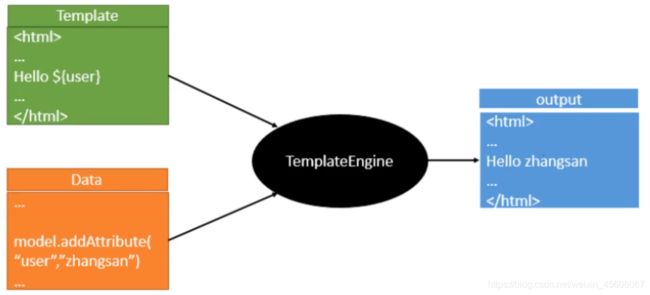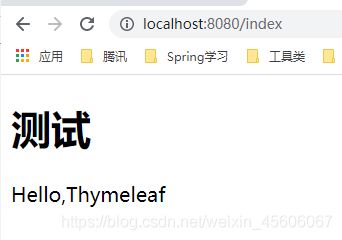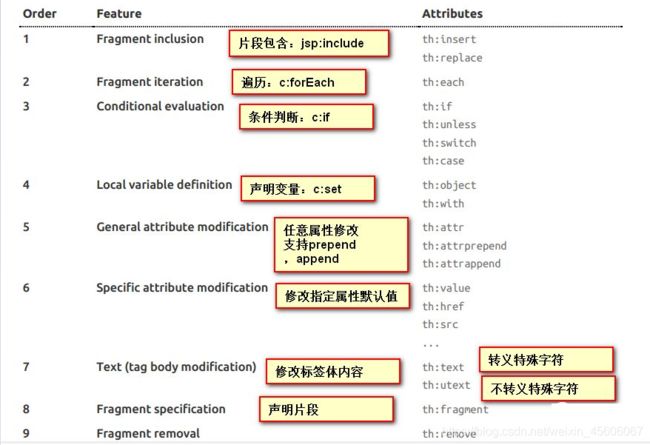SpringBoot(八)Thymeleaf模板引擎
模板引擎
前端交给我们的页面,是 html 页面。如果是我们以前开发,我们需要把他们转成 jsp 页面,jsp 好处就是当我们查出一些数据转发到JSP页面以后,我们可以用jsp轻松实现数据的显示,及交互等。
jsp 支持非常强大的功能,包括能写Java代码,但是呢,我们现在的这种情况,SpringBoot 这个项目首先是以 jar 的方式,不是 war;第二,我们用的还是嵌入式的Tomcat,所以呢,他现在默认是不支持 jsp 的。
那不支持 jsp,如果我们直接用纯静态页面的方式,那给我们开发会带来非常大的麻烦,那怎么办呢?
SpringBoot 推荐你可以来使用模板引擎:
模板引擎,我们其实大家听到很多,其实 jsp 就是一个模板引擎,还有用的比较多的 freemarker ,包括 SpringBoot 给我们推荐的Thymeleaf,模板引擎有非常多,但再多的模板引擎,他们的思想都是一样的,什么样一个思想呢我们来看一下这张图:

模板引擎的作用就是我们来写一个页面模板,比如有些值呢,是动态的,我们写一些表达式。而这些值,从哪来呢,就是我们在后台封装一些数据。然后把这个模板和这个数据交给我们模板引擎,模板引擎按照我们这个数据帮你把这表达式解析、填充到我们指定的位置,然后把这个数据最终生成一个我们想要的内容给我们写出去,这就是我们这个模板引擎,不管是 jsp 还是其他模板引擎,都是这个思想。只不过呢,就是说不同模板引擎之间,他们可能这个语法有点不一样。其他的我就不介绍了,我主要来介绍一下 SpringBoot 给我们推荐的Thymeleaf模板引擎,这模板引擎呢,是一个高级语言的模板引擎,他的这个语法更简单。而且呢,功能更强大。
引入Thymeleaf
怎么引入呢,对于 springboot 来说,什么事情不都是一个 start 的事情嘛,我们去在项目中引入一下。给大家三个网址:
Thymeleaf 官网:https://www.thymeleaf.org/
Thymeleaf 在Github 的主页:https://github.com/thymeleaf/thymeleaf
Spring官方文档:找到我们对应的版本
https://docs.spring.io/spring-boot/docs/2.2.5.RELEASE/reference/htmlsingle/#using-boot-starter
找到对应的 pom依赖:可以适当点进源码看下本来的包!
<dependency>
<groupId>org.springframework.bootgroupId>
<artifactId>spring-boot-starter-thymeleafartifactId>
dependency>
Thymeleaf分析
前面我们已经引入了 Thymeleaf,那这个要怎么使用呢?
我们首先得按照 SpringBoot 的自动配置原理看一下我们这个 Thymeleaf 的自动配置规则,在按照那个规则,我们进行使用。
我们去找一下Thymeleaf 的自动配置类:ThymeleafProperties
@ConfigurationProperties(prefix = "spring.thymeleaf")
public class ThymeleafProperties {
private static final Charset DEFAULT_ENCODING;
public static final String DEFAULT_PREFIX = "classpath:/templates/";
public static final String DEFAULT_SUFFIX = ".html";
private boolean checkTemplate = true;
private boolean checkTemplateLocation = true;
private String prefix = "classpath:/templates/";
private String suffix = ".html";
private String mode = "HTML";
private Charset encoding;
}
我们可以在其中看到默认的前缀和后缀;
我们只需要把我们的 html 页面放在类路径下的 templates 下,thymeleaf 就可以帮我们自动渲染了。
使用 thymeleaf 什么都不需要配置,只需要将他放在指定的文件夹下即可!
测试:
1、编写一个TestController
@Controller
public class TestController {
@RequestMapping("/t1")
public String test1(){
//classpath:/templates/test.html
return "test";
}
}
2、编写一个测试页面 test.html 放在 templates 目录下
<html lang="en">
<head>
<meta charset="UTF-8">
<title>Titletitle>
head>
<body>
<h1>测试页面h1>
body>
html>
3、启动项目请求测试
Thymeleaf 语法学习
要学习语法,还是参考官网文档最为准确,我们找到对应的版本看一下;
Thymeleaf 官网:https://www.thymeleaf.org/ , 简单看一下官网,我们去下载Thymeleaf的官方文档;
我们做个最简单的练习 :我们需要查出一些数据,在页面中展示;
1、修改测试请求,增加数据传输
@RequestMapping("/t1")
public String test1(Model model){
//存入数据
model.addAttribute("msg","Hello,Thymeleaf");
//classpath:/templates/test.html
return "test";
}
2、我们要使用 thymeleaf,需要在html文件中导入命名空间的约束,方便提示。
我们可以去官方文档的#3中看一下命名空间拿来过来:
<html xmlns:th="http://www.thymeleaf.org">
3、我们去编写下前端页面
<html lang="en" xmlns:th="http://www.thymeleaf.org">
<head>
<meta charset="UTF-8">
<title>Titletitle>
head>
<body>
<h1>测试页面h1>
<div th:text="${msg}">div>
body>
html>
4、启动测试!
OK,入门搞定,我们来认真研习一下Thymeleaf的使用语法!
1、我们可以使用任意的 th:attr 来替换Html中原生属性的值! 官网 #10
Simple expressions:(表达式语法)
Variable Expressions: ${...}:获取变量值;OGNL;
1)、获取对象的属性、调用方法
2)、使用内置的基本对象:#18
#ctx : the context object.
#vars: the context variables.
#locale : the context locale.
#request : (only in Web Contexts) the HttpServletRequest object.
#response : (only in Web Contexts) the HttpServletResponse object.
#session : (only in Web Contexts) the HttpSession object.
#servletContext : (only in Web Contexts) the ServletContext object.
3)、内置的一些工具对象:
#execInfo : information about the template being processed.
#uris : methods for escaping parts of URLs/URIs
#conversions : methods for executing the configured conversion service (if any).
#dates : methods for java.util.Date objects: formatting, component extraction, etc.
#calendars : analogous to #dates , but for java.util.Calendar objects.
#numbers : methods for formatting numeric objects.
#strings : methods for String objects: contains, startsWith, prepending/appending, etc.
#objects : methods for objects in general.
#bools : methods for boolean evaluation.
#arrays : methods for arrays.
#lists : methods for lists.
#sets : methods for sets.
#maps : methods for maps.
#aggregates : methods for creating aggregates on arrays or collections.
==================================================================================
Selection Variable Expressions: *{...}:选择表达式:和${}在功能上是一样;
Message Expressions: #{...}:获取国际化内容
Link URL Expressions: @{...}:定义URL;
Fragment Expressions: ~{...}:片段引用表达式
Literals(字面量)
Text literals: 'one text' , 'Another one!' ,…
Number literals: 0 , 34 , 3.0 , 12.3 ,…
Boolean literals: true , false
Null literal: null
Literal tokens: one , sometext , main ,…
Text operations:(文本操作)
String concatenation: +
Literal substitutions: |The name is ${name}|
Arithmetic operations:(数学运算)
Binary operators: + , - , * , / , %
Minus sign (unary operator): -
Boolean operations:(布尔运算)
Binary operators: and , or
Boolean negation (unary operator): ! , not
Comparisons and equality:(比较运算)
Comparators: > , < , >= , <= ( gt , lt , ge , le )
Equality operators: == , != ( eq , ne )
Conditional operators:条件运算(三元运算符)
If-then: (if) ? (then)
If-then-else: (if) ? (then) : (else)
Default: (value) ?: (defaultvalue)
Special tokens:
No-Operation: _
行内表达式:[[...]] or [(...)]
练习测试:
1、 我们编写一个Controller,放一些数据
@RequestMapping("/index")
public String index(Model model){
model.addAttribute("msg","Hello,Thymeleaf");
model.addAttribute("users", Arrays.asList("zhangsan","tom"));
return "index";
}
2、测试页面取出数据
<html lang="en" xmlns:th="http://www.thymeleaf.org">
<head>
<meta charset="UTF-8">
<title>Titletitle>
head>
<body>
<h1>测试页面h1>
<div th:text="${msg}">div>
<div th:utext="${msg}">div>
<h4 th:each="user :${users}" th:text="${user}">h4>
<h4>
<span th:each="user:${users}">[[${user}]]span>
h4>
body>
html>
3、启动项目测试!
表达式工具对象
在官方文档的 #19 ,这里我们就说两个常用的 dates、string
- #dates : utility methods for java.util.Date objects:
/*
* ======================================================================
* See javadoc API for class org.thymeleaf.expression.Dates
* ======================================================================
*/
/*
* Format date with the standard locale format
* Also works with arrays, lists or sets
*/
${#dates.format(date)}
${#dates.arrayFormat(datesArray)}
${#dates.listFormat(datesList)}
${#dates.setFormat(datesSet)}
/*
* Format date with the ISO8601 format
* Also works with arrays, lists or sets
*/
${#dates.formatISO(date)}
${#dates.arrayFormatISO(datesArray)}
${#dates.listFormatISO(datesList)}
${#dates.setFormatISO(datesSet)}
/*
* Format date with the specified pattern
* Also works with arrays, lists or sets
*/
${#dates.format(date, 'dd/MMM/yyyy HH:mm')}
${#dates.arrayFormat(datesArray, 'dd/MMM/yyyy HH:mm')}
${#dates.listFormat(datesList, 'dd/MMM/yyyy HH:mm')}
${#dates.setFormat(datesSet, 'dd/MMM/yyyy HH:mm')}
/*
* Obtain date properties
* Also works with arrays, lists or sets
*/
${#dates.day(date)} // also arrayDay(...), listDay(...), etc.
${#dates.month(date)} // also arrayMonth(...), listMonth(...), etc.
${#dates.monthName(date)} // also arrayMonthName(...), listMonthName(...), etc.
${#dates.monthNameShort(date)} // also arrayMonthNameShort(...), listMonthNameShort(...), etc.
${#dates.year(date)} // also arrayYear(...), listYear(...), etc.
${#dates.dayOfWeek(date)} // also arrayDayOfWeek(...), listDayOfWeek(...), etc.
${#dates.dayOfWeekName(date)} // also arrayDayOfWeekName(...), listDayOfWeekName(...), etc.
${#dates.dayOfWeekNameShort(date)} // also arrayDayOfWeekNameShort(...), listDayOfWeekNameShort(...), etc.
${#dates.hour(date)} // also arrayHour(...), listHour(...), etc.
${#dates.minute(date)} // also arrayMinute(...), listMinute(...), etc.
${#dates.second(date)} // also arraySecond(...), listSecond(...), etc.
${#dates.millisecond(date)} // also arrayMillisecond(...), listMillisecond(...), etc.
/*
* Create date (java.util.Date) objects from its components
*/
${#dates.create(year,month,day)}
${#dates.create(year,month,day,hour,minute)}
${#dates.create(year,month,day,hour,minute,second)}
${#dates.create(year,month,day,hour,minute,second,millisecond)}
/*
* Create a date (java.util.Date) object for the current date and time
*/
${#dates.createNow()}
${#dates.createNowForTimeZone()}
/*
* Create a date (java.util.Date) object for the current date (time set to 00:00)
*/
${#dates.createToday()}
${#dates.createTodayForTimeZone()}
- #strings : utility methods for String objects:
/*
* ======================================================================
* See javadoc API for class org.thymeleaf.expression.Strings
* ======================================================================
*/
/*
* Null-safe toString()
*/
${#strings.toString(obj)} // also array*, list* and set*
/*
* Check whether a String is empty (or null). Performs a trim() operation before check
* Also works with arrays, lists or sets
*/
${#strings.isEmpty(name)}
${#strings.arrayIsEmpty(nameArr)}
${#strings.listIsEmpty(nameList)}
${#strings.setIsEmpty(nameSet)}
/*
* Perform an 'isEmpty()' check on a string and return it if false, defaulting to
* another specified string if true.
* Also works with arrays, lists or sets
*/
${#strings.defaultString(text,default)}
${#strings.arrayDefaultString(textArr,default)}
${#strings.listDefaultString(textList,default)}
${#strings.setDefaultString(textSet,default)}
/*
* Check whether a fragment is contained in a String
* Also works with arrays, lists or sets
*/
${#strings.contains(name,'ez')} // also array*, list* and set*
${#strings.containsIgnoreCase(name,'ez')} // also array*, list* and set*
/*
* Check whether a String starts or ends with a fragment
* Also works with arrays, lists or sets
*/
${#strings.startsWith(name,'Don')} // also array*, list* and set*
${#strings.endsWith(name,endingFragment)} // also array*, list* and set*
/*
* Substring-related operations
* Also works with arrays, lists or sets
*/
${#strings.indexOf(name,frag)} // also array*, list* and set*
${#strings.substring(name,3,5)} // also array*, list* and set*
${#strings.substringAfter(name,prefix)} // also array*, list* and set*
${#strings.substringBefore(name,suffix)} // also array*, list* and set*
${#strings.replace(name,'las','ler')} // also array*, list* and set*
/*
* Append and prepend
* Also works with arrays, lists or sets
*/
${#strings.prepend(str,prefix)} // also array*, list* and set*
${#strings.append(str,suffix)} // also array*, list* and set*
/*
* Change case
* Also works with arrays, lists or sets
*/
${#strings.toUpperCase(name)} // also array*, list* and set*
${#strings.toLowerCase(name)} // also array*, list* and set*
/*
* Split and join
*/
${#strings.arrayJoin(namesArray,',')}
${#strings.listJoin(namesList,',')}
${#strings.setJoin(namesSet,',')}
${#strings.arraySplit(namesStr,',')} // returns String[]
${#strings.listSplit(namesStr,',')} // returns List
${#strings.setSplit(namesStr,',')} // returns Set
/*
* Trim
* Also works with arrays, lists or sets
*/
${#strings.trim(str)} // also array*, list* and set*
/*
* Compute length
* Also works with arrays, lists or sets
*/
${#strings.length(str)} // also array*, list* and set*
/*
* Abbreviate text making it have a maximum size of n. If text is bigger, it
* will be clipped and finished in "..."
* Also works with arrays, lists or sets
*/
${#strings.abbreviate(str,10)} // also array*, list* and set*
/*
* Convert the first character to upper-case (and vice-versa)
*/
${#strings.capitalize(str)} // also array*, list* and set*
${#strings.unCapitalize(str)} // also array*, list* and set*
/*
* Convert the first character of every word to upper-case
*/
${#strings.capitalizeWords(str)} // also array*, list* and set*
${#strings.capitalizeWords(str,delimiters)} // also array*, list* and set*
/*
* Escape the string
*/
${#strings.escapeXml(str)} // also array*, list* and set*
${#strings.escapeJava(str)} // also array*, list* and set*
${#strings.escapeJavaScript(str)} // also array*, list* and set*
${#strings.escapeJavaScript(str)} // also array*, list* and set*
${#strings.unescapeJava(str)} // also array*, list* and set*
${#strings.unescapeJavaScript(str)} // also array*, list* and set*
/*
* Null-safe comparison and concatenation
*/
${#strings.equals(first, second)}
${#strings.equalsIgnoreCase(first, second)}
${#strings.concat(values...)}
${#strings.concatReplaceNulls(nullValue, values...)}
/*
* Random
*/
${#strings.randomAlphanumeric(count)}
如果有收获!!! 希望老铁们来个三连,点赞、收藏、转发。
创作不易,别忘点个赞,可以让更多的人看到这篇文章,顺便鼓励我写出更好的博客



